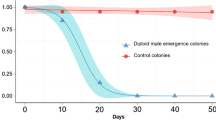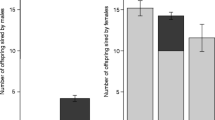Summary
InB. terrestris diploid males develop normally into adults (Duchateau et al., 1994). The diploid males are similar in appearance to the haploid males, except that they are smaller. The size of the testis of diploid males, relative to the length of the radial cell, is smaller than that of haploid males. There is overlap in the frequency distribution with respect to body size and testis size. The spermatozoa of diploid males are larger than those of the haploids and the vasa deferentia contain fair less spermatozoa than those of haploid males of the same age. Countings and measurements of the spermatozoa, therefore, can give the best indication about the ploidy of the males. Diploid males are successful in mating. They mate at a younger age than haploid males and they die sooner. The number of vial offspring of diploid males, however, is very low. No queen that mated with a diploid male produced a colony, but a few queens did produce some progeny. These might have been triploid males and workers. InB. terrestris higher ploidy results in smaller individuals, whereas in several other species of the Hymenoptera it has been found to result in larger individuals.
Similar content being viewed by others
References
Alford, D. V., 1975. Bumblebees. Davis-Poynter, London.
Bostian, C. H., 1936. Fecundity of triploid females inHabrobracon juglandis.Am. Nat. 70:40–41.
Brückner, D., 1976. The influence of genetic variability on wing symmetry in honeybees (Apis mellifera).Evolution 30:100–108.
Camargo, C. A. de, 1982. Longevity of diploid males, haploid males, and workers of the social beeMelipona quadrifasciata.J. Kansas Entomol. Soc. 55:8–12.
Chaud-Netto, J. and W. E. Kerr, 1980. Genetic mechanisms for the development of reproductive organs ofApis mellifera workers and diploid drones: a complementary hypothesis.Braz. J. Gen. 2:127–138.
Duchateau, M. J., 1989. The regulation of colony development in the bumblebee,Bombus terrestris. Ph D Thesis, University of Utrecht, The Netherlands.
Duchateau, M. J., H. Hoshiba and H. H. W. Velthuis, 1994. Diploid males in the bumble beeBombus terrestris: Sex determination, sex alleles and viability.Ent. exp. and appl. 71:269–276.
Eickwort, K. R., 1969. Differential variation of males and females inPolistes exclamans.Evolution 23:391–405.
Garófalo, C. A. and W. E. Kerr, 1975. Sex determination in bees. I. Balance between femaleness and maleness genes inBombus atratus Franklin (Hymenoptera,Apidae).Genetica 45:203–209.
Hung, A. C.F., S. B. Vinson and J. W. Summerlin, 1974. Male sterility in the red imported fire ant,Solenopsis invicta.Ann. Ent. Soc. Am. 67:909–912.
Kukuk, P. F. and B. May, 1990. Diploid males in a primitively eusocial bee,Lasioglossum (Dialictus) zephyrum (Hymenoptera: Halictidae).Evolution 44:1522–1528.
Medler, J. T., 1962. Morphometric studies on bumble bees.Ann. Ent. Soc. Am. 55:212–218.
Naito, T. and H. Suzuki, 1991. Sex determination in the sawfly,Athalia rosae ruficornis (Hymenoptera): Occurrence of triploid males.J. Hered. 82:101–104.
Owen, R. E., 1989. Differential size variation of male and female bumblebees.J. Hered. 80:39–43.
Packer, L. and R. E. Owen, 1990. Allozyme variation, linkage disequilibrium and diploid male production in a primitively social beeAugochlorella striata (Hymenoptera; Halictidae).Heredity 65:241–248.
Periquet, G., M. P. Hedderwick, M. El Agoze and M. Poirié, 1993. Sex determination in the hymenopteranDiadromus pulchellus (Ichneumonidae): validation of the one-locus multiallele model.Heredity 70:420–427.
Petters, R. M. and R. V. Mettus, 1980. Decreased diploid male viability in the parasitic wasp,Bracon hebetor.J. Hered. 71:353–356.
Plowright, R. C. and M. J. Pallett, 1979. Worker-male conflict and inbreeding in bumble bees (Hymenoptera: Apidae).Can. Ent. 111:289–294.
Röseler, P.-F., 1970. Unterschiede in der Kastendetermination zwischen den HummelartenBombus hypnorum undBombus terrestris.Z. Natur wiss. 25b:543–548.
Ross, K. G. and D. J. C. Fletcher, 1985. Genetic origin of male diploidy in the first ant,Solenopsis invicta (Hymenoptera: Formicidae), and its evolutionary significance.Evolution 39:888–903.
Ross, K. G. and D. J. C. Fletcher, 1986. Diploid male production — a significant colony mortality factor in the first antSolenopsis invicta (Hymenoptera: Formicidae).Behav. Ecol. Sociobiol. 19:283–291.
Smith, S. G. and D. R. Wallace, 1971. Allelic sex determination in a lower hymenopteran,Neodiprion nigroscutum Midd.Can. J. Genet. Cytol. 13:617–621.
Sokal, R. R. and C. A. Braumann, 1980. Significance tests for coefficients of variation and variability profiles.Syst. Zool. 29:50–66.
Woyke, J., 1963. Drone larvae from fertilized eggs of the honeybee.J. Apic. Res. 2:19–24.
Woyke, J., 1973. Reproductive organs of haploid and diploid drone honeybees.J. Apic. Res. 12:35–51.
Woyke, J., 1977. Comparative biometrical investigation on diploid drones of the honeybee I. The head.J. Apic. Res. 16:131–142.
Woyke, J., 1978a. Comparative biometric investigation on diploid drones of the honeybee II. The thorax.J. Apic. Res. 17:195–205.
Woyke, J., 1978b. Comparative biometrical investigation drones of the honeybee III. The abdomen, and weight.J. Apic. Res. 17:206–217.
Woyke, J., 1983. Lengths of haploid and diploid spermatozoa of the honeybee and the question of the production of triploid workers.J. Apic. Res. 22:146–149.
Author information
Authors and Affiliations
Rights and permissions
About this article
Cite this article
Duchateau, M.J., Mariën, J. Sexual biology of haploid and diploid males in the bumble beeBombus terrestris . Ins. Soc 42, 255–266 (1995). https://doi.org/10.1007/BF01240420
Received:
Revised:
Accepted:
Issue Date:
DOI: https://doi.org/10.1007/BF01240420




